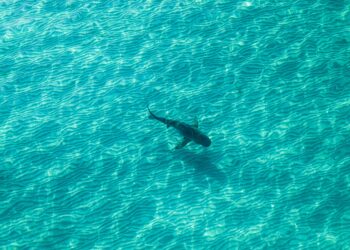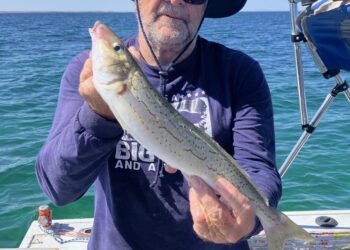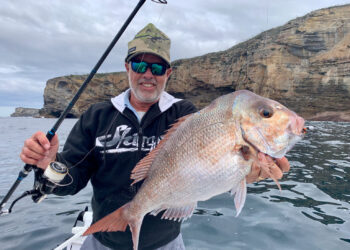SPECIES GUIDES: Kingfish
The kingfish fishery in SA is a unique one to say the least, and vastly different to most other fisheries around the country. We don’t get large numbers of kings, our fishery is localised to small pockets of water, it can be fickle at times (but, hey, what fishery isn’t?) and there’s only a narrow window of time each year. You’re probably thinking, “hmmm… sounds like hard work” and to some extent you’d be right. So what’s the appeal?
In all honesty, the average size of an SA king is in the 15–20kg category – fine fish indeed. We see a lot of 20–30kg kings in SA waters, and each year several thumping 40kg+ fish are caught – insane fish! I just did some quick calcs of kingfish we have caught in SA (some are estimated weights as we released the fish) and got 22kg as an average: that’s a pretty darn good fishery.
Having said that, the fish don’t always come easily; they require considerable time on the water. We have three main locations in the state famed for big kingfish: Port Augusta, Coffin Bay and Rocky/Greenly Island.
Port Augusta
Probably the most established and popular kingfish fishery in SA is found at Port Augusta, at the top of Spencer Gulf. Located about 300km from Adelaide, Port Augusta is a large hub servicing the rural region of the upper Gulf area. With about 14,000 residents, Port Augusta has the full range of amenities on offer so less forward-planning (compared to the other locations we’ll detail shortly) is required.
The kingfish at Port Augusta are at their peak in July and August, although some good fish are caught from May right through until October. The average size of a Port Augusta kingfish slots into the 15 to 25kg category, with plenty of 30kg+ fish taken as well.
Launching is via the local boat ramp, situated on the western side of town. From here it’s about a 5km run south to where the kingfish are targeted, but a further 5km or so to the livebait grounds. The standard practice at Port Augusta is to fish live squid (which can be caught over the weed beds in front of the shacks on the western side of the Gulf). If squid are scarce, then salmon trout can be caught closer to town. Once you have your tub of live squid, it’s time to backtrack to the power station, and then the waiting game begins.
The popular possies are (a) in front of the Old Playford power station, (b) in front of the inlet gates, and (c) in the warm water outlet channel. You’ll see a buoy-line restricting access to the upper reaches of the warm water channel.
Most of these positions will see you fishing in around 10m of water. Fishing the livebaits under a balloon will see results. Lightly weighting them and sending them down deeper (without a balloon) is more effective in the deeper areas around the power station. When you hook-up, it is common practice to up anchor (or even better – release the anchor rope on a buoy to quicken the process), and follow the fish to deeper water.
There are a few remnant pylon stumps sticking a metre or so from the seafloor (remains of an old wharf in front of Playford power station), so it pays to direct the fish into deeper water if you are able. We have lost a few fish over these cursed stumps – very frustrating. Once away from the shoreline, there are little obstacles to avoid and it is generally smooth sailing from here.
A few of the regular fishos at Port Augusta are starting to pin a few fish on surface poppers. While not a new technique for PA, it has definitely heightened in popularity over the past couple of seasons; and some great fish are now regularly being landed on surface lures.
Coffin Bay
This was the location that kick-started my affair with kingfish. “Coffins” is a stunning body of water, positioned on the south-western tip of the Eyre Peninsula. Located 650km west of Adelaide, it’s a fair trek to this remote bay system. There are a couple of general stores in town (selling fuel and supplies), a pub and caravan park plus a few units/holiday house rentals. Main supplies can be bought in Port Lincoln, which is a 45km drive from Coffin Bay.
Coffins is actually several bodies of branching bay water culminating one big inlet. One of the major benefits of Coffin Bay is there’s always a protected pocket of water to nestle in if the wind is up. The majority of fishing for kings in Coffins is done within a stone’s throw from the little township, right in the heart of the bay system. There are no big distances across water or rough seas to contend with here. In fact, having a small, highly manoeuvrable boat is a big advantage in this waterway.
The fish in Coffins are big. My smallest king from the bay was 18kg, with the average up around 25kg. It’s unusual to see fish below 15kg in Coffin Bay. Of all three locations detailed in this feature, Coffins probably produces less fish, but yields a slightly larger class of fish. This past season has been a good one for big fish, with several 40kg+ fish caught and released in the bay. These fish are in these bay settings prior to spawning, so catch & release is being adopted by most of the switched-on fishos in this area.
The peak time for Coffin Bay kings is October and November, although fish are sighted and caught from September through until early January. Live squid are the No.1 bait in Coffins, although they aren’t the easiest of livies to catch in the fast-flowing bay water. Some squid are caught in neighbouring Kellidie and Mt Dutton Bays where the flow is not as strong.
Live garfish and live salmon trout are a good second option if squid don’t play the game. Salmon trout can be caught on small diving and metal lures around Goat Island (in the bay) with garfish pretty reliable around the corner in Mt Dutton Bay.
Once some livies have been secured, it’s time to choose a possie and start the waiting game. Anchoring in the channel between Kellidie Bay and Seal Corner is the favoured stretch of water. The average depth through the channel is between 6m and 8m. In such shallow water, the fight is insane.
Once we have hooked up, we will pull anchor as soon as we can and give chase. The shorter the tether between you and the fish, the less chance the fish has of locating structure. There isn’t a lot of natural structure to watch out for, but there are a few man-made obstacles to be wary of when fighting a fish. There are several channel markers, a heap of mooring buoys in front of the township and oyster racks throughout the bay, plus there’s generally a few other boats in the narrow channel to avoid. It’s usually an intense fight.
Greenly & Rocky Islands
The final location in SA’s top kingfish haunts takes us offshore. While the past two locations have been shallow water settings, this time we’re fishing deeper water around a couple of islands known as Rocky and Greenly. These two islands lie off the south-western tip of the Eyre Peninsula. To access these islands, you launch at the Coffin Bay boat ramp, and then steam some 60km offshore from the bay. It’s a long way offshore and is definitely the domain of 6.5m+ boats.
There are a couple of charter boats that access these waters, and these are a worthwhile investment if your boat’s not up to the long haul offshore. When accessing these islands, we generally spend a night or two in the anchorage of Greenly to make the long trip even more worth the while. The majority of fishing for the kings takes place right in the heart of the anchorage. A south to south easterly wind is preferred, with any wind from the north making for a pretty uncomfortable night. The peak time for these kings is January to March, which coincides with some of the better weather windows.
These offshore kings are big fish, too, generally 20kg+. These night time kings are targeted using live baits of squid, mackerel, yellowtail scad or silver trevally. The anchorage is around 25m in depth, so extra weight is important in getting the livie down deep. When a big hook-up does come your way, the only real obstacle will be your own anchor rope. At night it’s not the best practice to up-anchor to chase these fish in the anchorage …
The biggest of the kings come out to play during the night, but during the day some smaller to mid-sized kings can be caught in the anchorage on livebaits and soft plastics. These fish are usually in the five to 10kg size range, and are a whole lot of fun on downsized tackle.
Moving away from the sheltered anchorage, some good kingfish are caught from the deeper reefs wide of Greenly, and down around Rocky Island. Some of the kingfish-producing reefs are on the charts, and rise from around 90m up to about 55m from the surface. The majority of these open-water fish are a tad smaller, and slot in the 10–15kg size range on average. These fish are targeted by livebaiting these deep reefs, and also heavy metal jigging.
That’s a brief rundown of our top kingfish haunts in SA. Each location is different, offering different challenges, different surroundings and a slightly different class of fish. While you may not find the numbers of fish flowing like in other locations, the class of our fish is sure to impress.





















